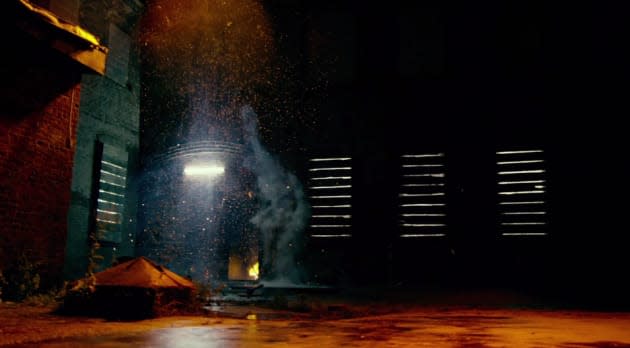The challenges of running a modern VFX Studio

We've come a long way since the Harryhausen-era of special effects. Instead of countless hours spent adjusting claymation models, modern VFX require more computer processing power than the moon mission. But while they seamlessly blend into our storytelling, creating convincing special effects is still no easy feat. Just ask Shade VFX CEO, Bryan Godwin.

Shade VFX CEO, Bryan Godwin.
Shade VFX opened in 2009 as a five-person studio based in Santa Monica. As the company grew in size, it eventually expanded and opened a sister site in New York City. But with its operations separated by 2,680 miles of North American continent, efficiently and securely sharing production assets can be difficult. That's why Shade employs a dedicated fiber optic line to link its two offices."It was critical to the entire [expansion] strategy," Godwin told Engadget. "It allows us to operate like there's a single data center here in Santa Monica and everybody connects the PCOIP [PC over IP] from both Santa Monica and New York."
PCOIP is a proprietary protocol that works by mirroring the images of software running on a central server to the endpoint workstation. That is, it takes the digital image of whatever is running on the server, compresses and encrypts it, and then transmits it to the end-point where the signal is decrypted and uncompressed. In this manner, every Shade employee has access to the same constantly-updated resources, regardless of the office they work from and without the need for VPN shenanigans. "Additionally, NYC is a pretty challenging place," Godwin continued, "because it can be difficult to get enough power to house a proper render farm."
So by hosting the data and servers in Santa Monica, the company avoids having to blow cash on building out unnecessary infrastructure. "It also maintains a clean line which is critical for running PCOIP over that kind of distance," said Godwin. "It's more about lag times and lost packets than it is about bandwidth. In fact it doesn't even really take that much bandwidth, it's the cleanliness of the line that matters. We rarely were capping bandwidth -- it was far more about QoS (quality of service) than how much info was being pushed through." You'd be surprised how often that's is necessary when working with 4K video.
"Before we switched to the fiber/layer 2 connection, packets got routed all over the place and not only would we see significant packet loss, we'd see OOS (out of sequence) packets," Godwin continued. "That means on the decoding end of service, the chipset had to work harder to reorder those packets into the expected sequence." However since layer 2 isn't actually the internet, data is transmitted in the same manner as over a LAN, which translates into a significant performance boost. Basically, the fiber system allows their data to shoot directly between nodes rather than be broken down and transmitted in random bits -- think Star Trek transporters rather than The Fly transporters.

Before special effects.
While 4K televisions are still relatively rare outside of early adopters, Hollywood is forging ahead with creating content at that resolution. And though the new standard required far more specialized and expensive equipment to capture and manipulate just a few years ago, that's no longer the case. "We're finding that a lot of the software and hardware is catching up to 4K pretty quickly," Godwin told Engadget. "But most of the challenges tend to be of an artistic nature where we used to be able to get away with far less detailed trickery."

After special effects.
Of course, that artistic trickery still demands a fair amount of technological magic to accomplish including HDR cameras, studio green screens and no shortage of old-school physical effects work. HDR, or high dynamic range, is an imaging system that captures a larger range of luminosity than what a conventional camera can. With more light, colors appear more vibrant, contrast increases and scenes appear closer to what we see in reality. "We have an HDR pipeline [that] gives our compositors an incredible amount of latitude to, say, change exposure, to relight and adjust everything that comes out of our 3D animators' rendering rigs," Godwin said.
The company also relies on traditional, non-computerized special effects to compliment the CGI. Shade's Santa Monica studio boasts a 20-foot by 30-foot green screen for capturing specific effect elements such as crowds or blood splatter. As Godwin explained, "sometimes it's just easier to shoot something than to recreate it in CGI. It's a lot faster to just throw some blood at a wall than do a whole fluid simulation."

Before special effects.
You can see -- in theory at least -- numerous examples of Shade VFX's work in the first season of Daredevil (and the upcoming Jessica Jones series). "Our brand is really about 'invisible effects', we specialize in is the stuff that supports the story but which you don't notice is there," Godwin said. "It doesn't have to be a giant dragon mowing down thousands of horseback knights to be visual effects -- there are visual effects in everything from Rom-Coms up to Lord of the Rings." The company provided more than a 1000 effects for DareDevil, approximately 75 each episode. Even more impressive, they created effects for all 13 episodes in just 5 months, according to Godwin.

After special effects.
"We only seem to see the 'bad' CGI and we miss the rest of the 'good' CGI," Godwin concluded. "Our ego lies within being the 'ninjas of special effects.' We know we've done our job really well if you have no idea we were there in the first place."

